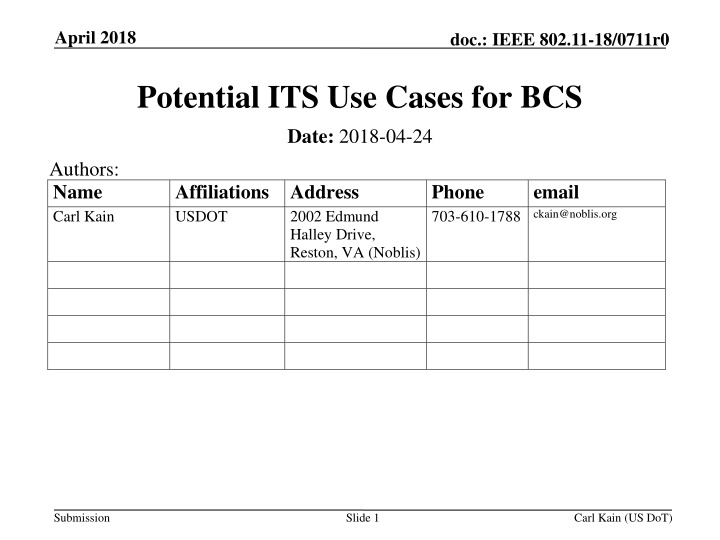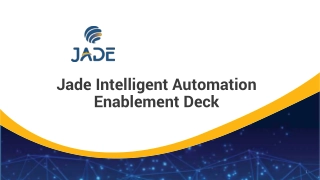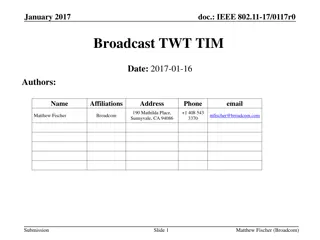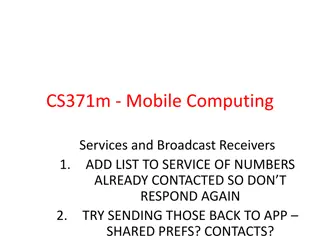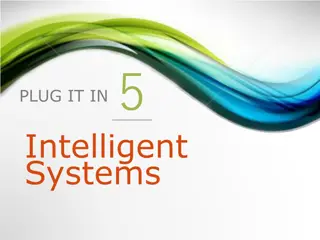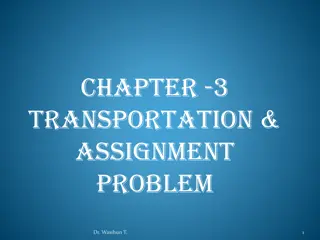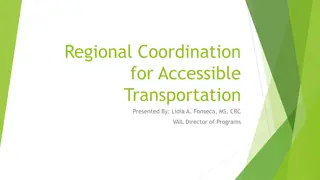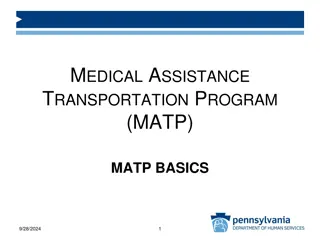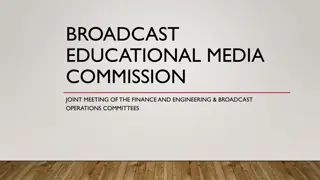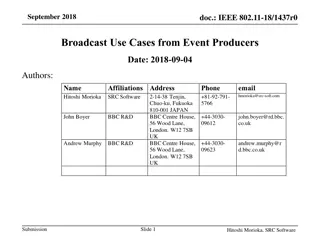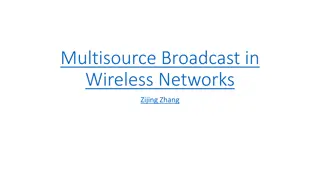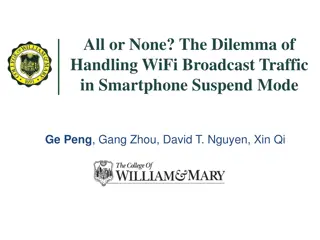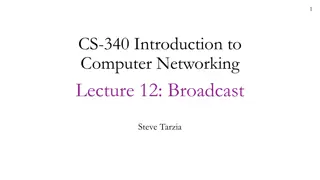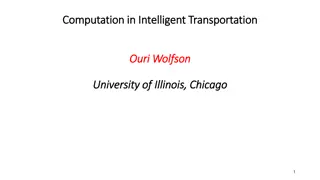Potential Intelligent Transportation System Use Cases for Broadcast Services Study Group
This presentation highlights potential Intelligent Transportation System use cases for consideration by the Broadcast Services Study Group. The use cases were derived from the Architecture Reference for Cooperative and Intelligent Transportation (ARC-IT). While not exhaustive, the presentation provides valuable insights into transportation-related scenarios that could benefit from Broadcast Services.
Download Presentation

Please find below an Image/Link to download the presentation.
The content on the website is provided AS IS for your information and personal use only. It may not be sold, licensed, or shared on other websites without obtaining consent from the author.If you encounter any issues during the download, it is possible that the publisher has removed the file from their server.
You are allowed to download the files provided on this website for personal or commercial use, subject to the condition that they are used lawfully. All files are the property of their respective owners.
The content on the website is provided AS IS for your information and personal use only. It may not be sold, licensed, or shared on other websites without obtaining consent from the author.
E N D
Presentation Transcript
April 2018 doc.: IEEE 802.11-18/0711r0 Potential ITS Use Cases for BCS Date: 2018-04-24 Authors: Name Carl Kain Affiliations Address USDOT Phone 703-610-1788 ckain@noblis.org email 2002 Edmund Halley Drive, Reston, VA (Noblis) Submission Slide 1 Carl Kain (US DoT)
April 2018 doc.: IEEE 802.11-18/0711r0 Abstract This presentation contains potential Intelligent Transportation Systems use cases for consideration by the Broadcast Services Study Group. Use cases were extracted from the Architecture Reference for Cooperative and Intelligent Transportation (ARC-IT). The use cases in this presentation are not an exhaustive list of transportation- related use cases for BCS. Submission Slide 2 Carl Kain (US DoT)
April 2018 doc.: IEEE 802.11-18/0711r0 802.11 Template Instructions 1/4 To properly identify your PowerPoint presentation as an IEEE 802.11 Submission there are 7 steps that you must complete, and 12 data fields that you must fill in. Step 1. Obtain a document number (has the form yy/xxxx). Step 2. Title slide: Fill in the presentation subject title text, the full date (in ISO 8601 format of YYYY-MM-DD), and the complete author(s) details (a total of 3 data fields). Step 3. Abstract slide: Fill in the abstract text. Step 4. Press Office button, Prepare / Properties. Fill in the 2 data fields: Author field = first author's name Title field = Title of presentation Submission Slide 3 Carl Kain (US DoT)
April 2018 doc.: IEEE 802.11-18/0711r0 802.11 Template Instructions 2/4 Step 5. Menu select View, Master, Slide Master, select the top master page (theme slide master). Place the document designator in the right hand side of the header. Document designator example "doc.: IEEE 802.11-04/9876r0" , or "doc.: IEEE 802.11-04/9876r2" Step 6. Menu select Insert, Header and Footer (5 data fields): Slide tab: Date & Time, Fixed = venue date (as Month Year, e.g. January 2005) Footer = first author, company Notes tab: Data and time, Fixed = venue date (as Month Year, e.g. January 2005) Header = document designator (e.g. doc.: IEEE 802.11-04/9876r0 ) Footer = first author, company Click "Apply to all". Step 7. Delete the four template instruction slides. Submission Slide 4 Carl Kain (US DoT)
April 2018 doc.: IEEE 802.11-18/0711r0 802.11 Template Instructions 3/4 PowerPoint Submission Preparation Summary: Things to do: 7 Fields to fill in: 12 Submission Slide 5 Carl Kain (US DoT)
April 2018 doc.: IEEE 802.11-18/0711r0 802.11 Template Instructions 4/4 Recommendations a) Always create a new presentation using the template, rather than using someone else's presentation. b) For quick and easy creation of new 802.11 submissions, place the 802.11 template files in the template folder area on your computer. Typical locations are: c:\Program Files\Microsoft Office\Templates\802.11, or c:\Documents and Settings\User Name\Application Data\Microsoft\Templates\802.11 To create a new submission from within PowerPoint, menu select File, New, then select the appropriate 802.11 template file. c) When you update or revise your presentation, remember to check all 6 fields in steps 5 and 6 for the correct values. rev: 2010-03-01 Submission Slide 6 Carl Kain (US DoT)
April 2018 doc.: IEEE 802.11-18/0711r0 Introduction to ARC-IT The Architecture Reference for Cooperative and Intelligent Transportation (ARC- IT) provides the reference architecture for ITS in the United States (with some content from EU, AU) Twenty year evolution of architecture content (v1.0 in 1996, 8.1 in 2018) Provides the basis for all local ITS installations Four interrelated viewpoints to address stakeholder concerns Enterprise: organizations and individuals and their roles and relationships Functional: functionality and data exchanges (abstract) Physical: allocation of functions to physically bounded objects. Information exchange. Communications: characterization of information exchanges. Identification of complete (all layers) collection of protocols to satisfy information exchanges Defines 139 services provided by ITS Each service typically addresses several use cases Often each service also combines several scenarios for service delivery Submission Slide 7 Carl Kain (US DoT)
April 2018 doc.: IEEE 802.11-18/0711r0 ARC-IT Views ( ARC-IT , www.arc-it.org) Service Packages Submission Slide 8 Carl Kain (US DoT)
April 2018 doc.: IEEE 802.11-18/0711r0 Acronyms and Definitions RSE-Roadside Equipment-fixed equipment installed on the roadside, may be portable/temporary for some installations such as work zones, detours, and accident scenes. PID-Personal Information Device-a portable device e.g. smartphone or tablet OBE-On Board Equipment-mobile device installed in a light vehicle, commercial vehicle, rail car, bus, subway etc. TIC-Transportation Information Center Availability and Integrity definitions are found in the Federal Information Processing Standard (FIPS) Publication 199: Standards for Security Categorization of Federal Information and Information Systems Submission Slide 9 Carl Kain (US DoT)
April 2018 doc.: IEEE 802.11-18/0711r0 Some Caveats Use cases do not involve low-latency safety of life applications that are more appropriate for IEEE 802.11p-2010. However, many of these use cases could be implemented with IEEE 802.11p-2010 if the users were properly equipped. Use cases are categorized as broadcast in ARC-IT. Use cases presented would benefit from a BCS amendment; BCS may provide an inexpensive means for deployment of ITS services. Submission Slide 10 Carl Kain (US DoT)
April 2018 doc.: IEEE 802.11-18/0711r0 Advanced Railroad Grade Crossing Submission Slide 11 Carl Kain (US DoT)
April 2018 doc.: IEEE 802.11-18/0711r0 Advanced Railroad Grade Crossing RSE -> arriving train information -> PID/OBE Information for a train approaching a highway-rail intersection that may include direction and allow calculation of approximate arrival time and closure duration. Short range, immediately and nearby relevant information. High Integrity and Moderate Availability requirements. PID -> personal location The current location (latitude, longitude, and elevation) reported by the personal information device Short range, immediately and nearby relevant information. High Integrity and Moderate Availability requirements. This flow appears in arterial service packages as well so has more uses and would be generally valuable if we could make it happen. Submission Slide 12 Carl Kain (US DoT)
April 2018 doc.: IEEE 802.11-18/0711r0 Broadcast Traveler Information Submission Slide 13 Carl Kain (US DoT)
April 2018 doc.: IEEE 802.11-18/0711r0 Broadcast Traveler Information Description: General traveler information that contains traffic and road conditions, link travel times, incidents, advisories, restrictions, transit service information, weather information, parking information, and other related traveler information. This flow appears in four service packages: Broadcast Traveler Information, Dynamic Route Guidance, Work Zone Management and Connected Eco-Driving. Always originates with a Transportation Information Center, and terminates at a Vehicle OBE or PID. Assigned to wide area wireless for which we have no good solution, since this is a wide area broadcast, but not emergency-level information. Spatial context tends to be large-area, Integrity requirements Moderate, Availability can be Moderate depending on the context. Submission Slide 14 Carl Kain (US DoT)
April 2018 doc.: IEEE 802.11-18/0711r0 RSE->OBE Broadcast Flows that are not Crash-Imminent related RSE -> lane closure information -> OBE Lane closure information provided to passing vehicles. This flow provides information about roadway configuration changes such as lane closures and shifts. Short range, immediately and nearby relevant information. Moderate Integrity requirements. RSE -> local traveler information -> OBE/PID Traveler information including traffic, road, and weather conditions for a particular locality. This flow includes the location-specific traveler information and time effectivity of the information. Short to medium range, immediately and nearby relevant information. Moderate Integrity requirements. RSE -> low emissions zone parameters -> OBE The geographic boundaries, time period, and fee structure for a low emissions zone. This flow also provides the specific restrictions that are in place for the zone including admittance requirements and rules and restrictions for driving within the zone. Moderate Integrity and Availability requirements. Submission Slide 15 Carl Kain (US DoT)
April 2018 doc.: IEEE 802.11-18/0711r0 RSE->OBE Broadcast Flows that are not Crash-Imminent related RSE -> parking facility geometry -> OBE Precise spatial description of a parking facility that locates each parking space and the ingress and egress routes that are used to travel to and from the spaces. High Integrity and Moderate Availability requirements. RSE -> reduced speed notification -> OBE Reduced speed zone information provided to passing vehicles. This flow provides the reduced speed limit, the location and extent of the reduced speed zone, and associated warning information. Moderate Integrity and Moderate Availability requirements. RSE -> restricted lanes information -> OBE This flow defines the location, duration, and operating parameters for lanes that are reserved for the exclusive use of certain types of vehicles (e.g., transit vehicles) or vehicles that meet other qualifications (e.g., number of occupants, low emissions criteria). It identifies the lane(s), the start and stop locations, start and end times, vehicle restrictions, speed limits and platooning parameters. Moderate Integrity and Moderate Availability requirements. Slide 16 Submission Carl Kain (US DoT)
April 2018 doc.: IEEE 802.11-18/0711r0 RSE->OBE Broadcast Flows that are not Crash-Imminent related RSE -> transit stop guidance -> PID Information sent from bus stop infrastructure to portable devices that includes stop- specific bus schedules and routes. Focused on the visually impaired but applicable to all. Moderate Integrity and Moderate Availability requirements. RSE -> vehicle signage data -> OBE In-vehicle signing data that augments regulatory, warning, and informational road signs and signals. The information provided would include static sign information (e.g., stop, curve warning, guide signs, service signs, and directional signs) and dynamic information (e.g., current signal states, grade crossing information, local traffic and road conditions, detours, advisories, and warnings). Moderate Integrity and Moderate Availability requirements. Submission Slide 17 Carl Kain (US DoT)
April 2018 doc.: IEEE 802.11-18/0711r0 Personal Safety RSE -> personal crossing safety information -> PID Current crossing status including permission to cross, crossing time remaining, and warnings in the event that a vehicle reports an imminent intersection infringement that may impact non-motorized users including pedestrians and cyclists. Short range, immediately and nearby relevant information. Moderate integrity requirements. Submission Slide 18 Carl Kain (US DoT)
April 2018 doc.: IEEE 802.11-18/0711r0 References The Architecture Reference for Cooperative and Intelligent Transportation (ARC-IT) WWW.ARC-IT.ORG Submission Slide 19 Carl Kain (US DoT)
